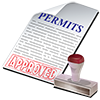How-To Guide
These are the steps from daydream to completion of your ADU or Junior ADU. An overview of the process can be helpful for understanding what to expect from the design, permitting, and construction phases of the project.

Pre-Application Phase
- Use the GIS tool to determine the eligibility of your parcel and the maximum size ADU you could build
- Consult the ADU Financing Guide to estimate your ballpark costs.
- Call or Email the Zoning Counter to discuss options as well as any constraints or site-specific factors (steep slopes, double frontages, agricultural buffer setbacks, existing accessory structures, septic systems, etc.) that could require additional consideration. This step will help you avoid surprises after investing time and money into a building design.
- If your home relies on a septic system for sanitation, consult with the Environmental Health Department about the capacity of your existing system.
Reach the Zoning Counter by calling or emailing:

Design Phase
Design and Preparation
- Will the ADU be built as a New Construction or as a Conversion ADU? Consult the ADU Design Guide for guidance and inspiration.
- Consider your options for drafting plans. You could hire a designer or architect, draw your own plans, purchase a set of stock building plans or consider purchasing a manufactured home or pre-fab unit.
- Consider your options for building. Will you hire a contractor to build the unit? Will you construct the unit yourself?
- Once you select an ADU design option, you can get an estimate of County fees by using the Fee Estimator.
- Design your project to minimize stormwater runoff from impervious and semi-impervious surfaces. Construct flatwork like parking areas and patios using pervious pavers, porous concrete, or gravel with a stabilizing grid. These materials allow runoff to infiltrate into the soil which reduces the amount of stormwater runoff.
- With your preliminary design, the Building Counter can provide a list of plan submittal requirements.
Reach the Building Counter by emailing:

Permitting Phase
Submit Plans for Building Permit
Submit your plans and building permit application using the County’s online ePlan system. Expect 2 rounds of comments/re-submittals; in addition to building plan check, plans are typically reviewed by zoning, environmental planning, the Department of Public Works, and fire districts. Each round of submittal review may take up to 60 days.
Record Deed Restriction if Applicable
For all properties with JADUs, and for all properties with ADUs except for those permitted between 1/1/20 and 1/1/25, the property owner must reside in either the primary home or the ADU/JADU. Confirmation of a Homeowner’s Tax Exemption is required prior to permit issuance, and a restriction on the property’s deed stating this requirement must be recorded before the Building Permit can be issued. This requirement will apply to all future owners of the property.

Obtain Permits and Pay Fees
- Obtain your building permit and any other necessary permits.
- Pay all fees as required. Fees vary both by size (small units are exempt from certain fees) and by method of construction (Conversion ADUs are not subject to several fees). See the ADU Fee, Cost and Cash Flow calculator and ADU Financing Guide for more information about fee.
Construction & Occupancy
Construct Your ADU
Complete all Required Building and Environmental Inspections at appropriate stages of the construction process.
Occupy your ADU
If you will be renting the ADU, the information in ADU Financing Guide: ADUs as Rental Property about how to be a landlord, accepting housing vouchers, etc. may be valuable.